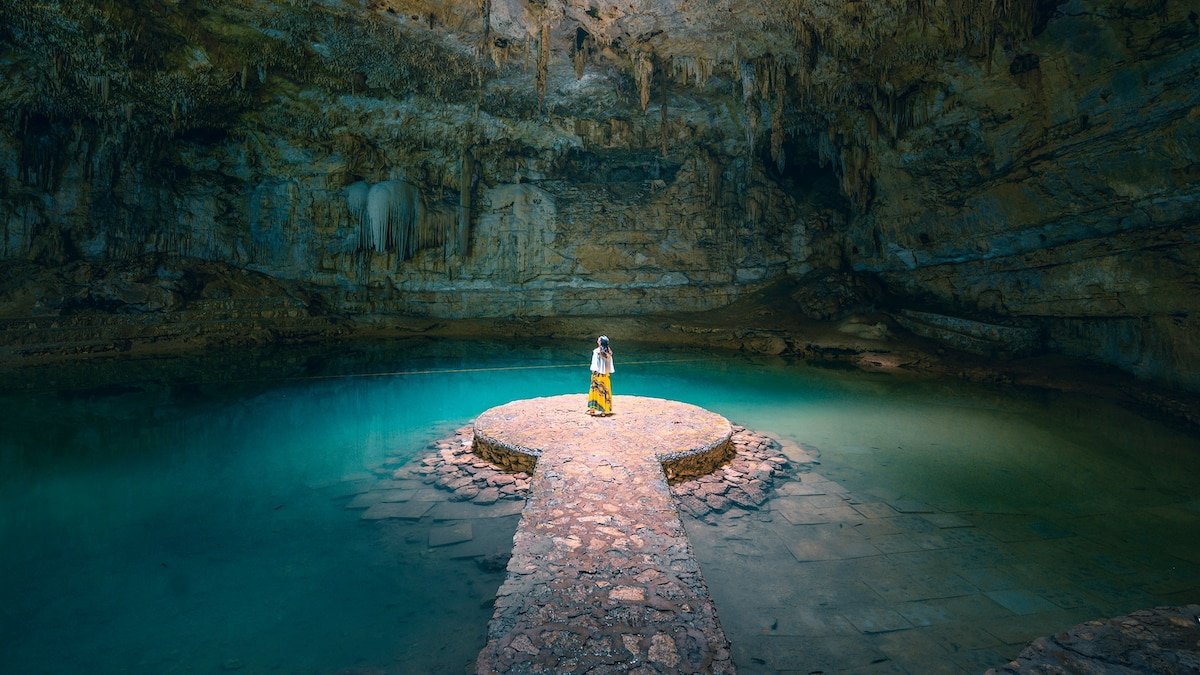Caves were central to the human experience, as early shelters and sacred religious sites. But eventually humans crawled out of the caves, stood up, looked around, and realized there was something more comfortable in the outside world. These days, wellness caves welcome travelers back underground in search of darkness, silence, solitude, and perhaps spiritual enlightenment.
These underground hideaways range from rustic to luxurious and stylish, and some are man-made, carved into the ground or piled with earth on top of rock, like Sky Cave Retreat in Oregon and Dark Retreat Earth Dome in Thailand, while others are naturally formed, like the famous Dhangeshwari Caves. Bodh Gaya The caves in Bihar, India, are believed to be where the young Buddha hid. Once considered a place of last resort, caves are now often used for recreational activities such as yoga classes, sound baths and meditation. What connects these spaces is a sense of retreat, reflection and resetting.
Caves are both sacred and social places
Religious and social groups have long gathered in caves. In Central America, the Maya people went to caves to make offerings to their gods, ingest mind-altering substances, and occasionally make human sacrifices. Tibetan Buddhist “dark retreats” last from three to 49 days, during which advanced practitioners sit in caves and meditate on their mortality. Ancient Greek and Roman Christians probably used vast, labyrinthine catacombs for private worship or to escape prosecution.
(Inside the “Cave of Hell” in Ireland, where Halloween was born.)
Travelers probably don’t plan to spend weeks underground, but hikers in Bhutan’s Dochula Pass can venture off to a small, open meditation cave for some quiet time with views of the lush forest and rugged mountains. Forest of Peace Retreat, a 20-minute drive from Tulsa, Oklahoma, invites visitors to its “Mother’s Cave,” a storm shelter converted into a meditation space.
“There’s a curiosity that sensory deprivation practices might open our eyes to something bigger that lies within us,” says Tim McHenry, chief programming officer at the Rubin Museum of Art in New York City, which has hosted dark meditations in a cave-like space at its Himalayan Cultural Center. “Total darkness is a very rare experience.”

Sky Cave Retreats in Oregon offers a soundproofed basement built into the side of a hill and accessed by a ladder through an opening at the top. Photo courtesy of SkyCave Retreats
Cave of healing
Spending time in darkness may even have health benefits: “Scientists began studying REST in the 1960s. [Restricted Environmental Stimulation Therapy]”They’re finding that it’s really beneficial for calming the nervous system and relaxing,” says Scott Berman, founder of Sky Cave Retreats in Oregon.
Research has shown that spending time in complete darkness can be particularly effective for certain mental health issues and vision problems. Since its popularity in the 1960s (largely due to German anthropologist Holger Kallweit), darkness therapy has been used effectively to treat symptoms of bipolar disorder. It can also be effective for chronic fatigue syndrome, migraines, and recent studies have shown it can have a positive effect on people with amblyopia (aka “lazy eye”).
As a result, dozens of dark retreat centers have opened across Europe. Now the therapy is gaining popularity in North America, too, with support from celebrities like NFL player Aaron Rodgers and actress Rosario Dawson. For professional athletes and creatives, dark retreats offer the perfect escape from the hustle and bustle of social life. “Sitting on the couch all day or scrolling through your phone is death,” Dawson said after four days at Sky Cave. “The retreat made me realize I needed to develop a deeper, more loving relationship with my body.”
“The underworld teaches us to respect mystery,” author Will Hunt argues in his 2019 book. underground: human The history of the world at our feet. Hunt said his exploration of subway tunnels, catacombs and caves had led him to realise “you don’t always have to reveal everything”.
(This Slovenian cave is truly the “House of the Dragon.”)
How to enjoy a cave retreat
At Sky Cave Retreat, visitors stay overnight (or for weeks) in 300-square-foot underground suites built from cinderblock and rebar into the hillside. The suites are furnished with beds, floor pillows, rugs, and wood-burning stoves. These “caves” are warm and insulate from light and sound. “The lack of noise is something a lot of people don’t expect,” says Berman. “It gives people a sense of timelessness. You enter into a reality that doesn’t change.” Staff deliver meals (which you eat in darkness), and each suite has a private bathroom, a flushing toilet, and a bathtub for quiet, warm soaks.
The Samaya Meditation Center in Indonesia has a similar setup, inviting practitioners to book for three full days in a simple but cozy, dark room. Plant-based meals are served, and although the room isn’t completely soundproof, each guest is given earplugs on arrival.
Of course, you don’t have to commit days to feeling an inner transformation: you can visit a Himalayan salt cave for an hour or rent a room carved into the side of Tres Cuevas mountain at Summit in Big Bend, Texas. A group session of cave yoga at Olentangy Caverns in Ohio is an active way to enjoy the underground, and many parks offer private guided cave tours. Whether you can spare an hour or a month, visitors can now find many different ways to play in the dark.
(The site of Sleeping Beauty’s cave is waking up to tourism.)

